When Queen’s Park Women appointed Craig Joyce as their new head coach back in the summer of 2022, the main target that he and they had was promotion to the Scottish Women’s Premier League or SWPL 1 and a chance to test themselves against the best that the Scottish women’s game has to offer.
Whilst his first campaign was nothing to write home about, with mixed results leading to the team finishing third from bottom, it has been quite the turnaround during the current campaign for Queen’s Park, who are based just down the road from Ibrox Stadium at New Tinto Park, with them currently seven points clear at the top of the table with 10 victories in their opening 11 matches.
With that in mind, this tactical analysis will take a closer look at the Glasgow team’s tactics under Joyce, detailing how they have gone from a struggling side to the summit in a matter of months. The scout report will break down key aspects of their attacking and defensive play and will show why teamwork has been central to their progress.
Build-up play
When watching Queen’s Park Women play, the thing that is immediately clear is their desire to be progressive whenever they are in possession, with them always aiming to move the ball forwards and only settling for a sideways or a backwards pass when there is no alternative.

In order to make that possible, their tactics in possession are centred around getting players into the middle channel and positioning them in a straight line, as has happened here with Rachael McConnachie and Sophie McGoldrick, with the former receiving the ball and the latter moving ahead of her to provide a passing option.
This is not easy to execute, with it going against players’ instincts and seeing them make the pitch compact whenever they have the ball and there is always an inherent risk at doing this due to there being no ways out if the pass up the pitch goes astray. However, this is not something that Queen’s Park have ever been too concerned about, with them being brave in possession and believing in their overall game plan, and Joyce does need to take plenty of credit for that as it comes down to him introducing a positive mentality this season and ensuring that every player is pulling in the right direction.
It is also worth noting that, in this case, Queen’s Park have looked to minimise the risk by positioning midfielder Ellie Kane just to the side of the vertical line between McConnachie and McGoldrick, with the result being that Glasgow Women defender Leah Donnelly is forced to stay with her and to not work with Rebecca McGarvey to close McGoldrick down. However, that doesn’t take away from the fact that Queen’s Park needed to have the bravery and positivity to make this pass possible. The fact that they have had that on plenty of occasions this season is one reason for them being such a dangerous opponent so far.
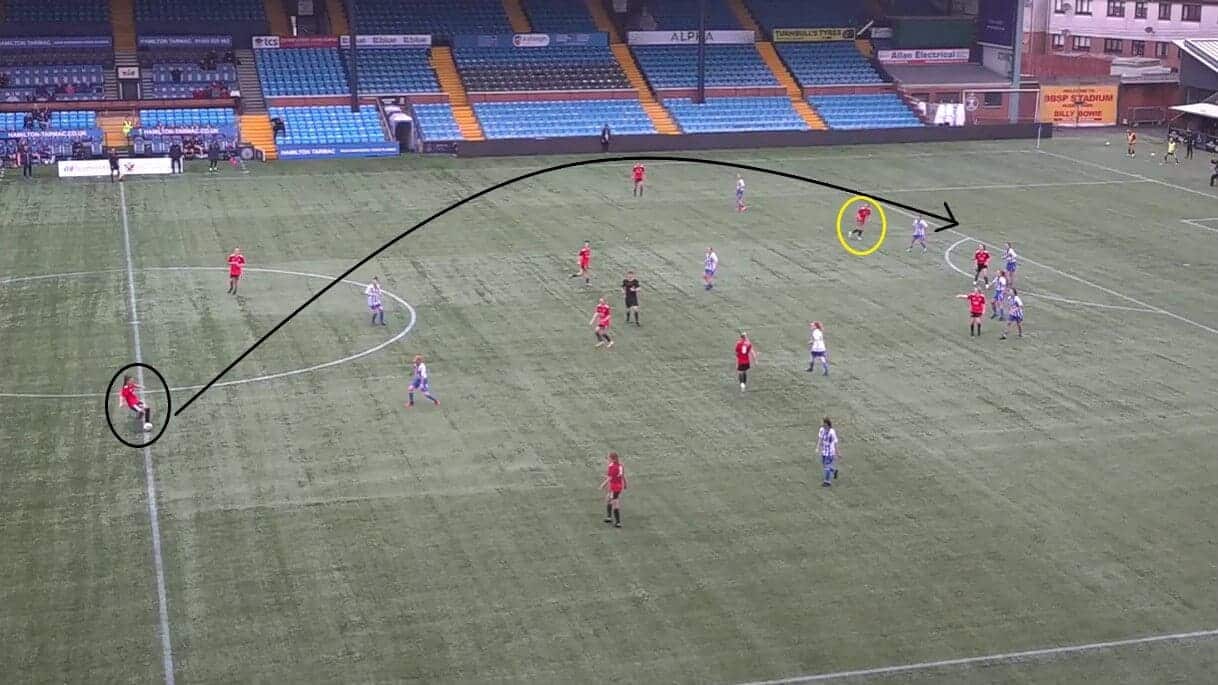
However, any team who wants to maintain a title challenge needs to be adaptable, and Queen’s Park do have other ways of building play if that tactic doesn’t have the desired effect. The trip to Kilmarnock Women was one of those when they did need to find another way of accessing the territory behind the opposing defensive line, with Kilmarnock staying organised and resilient behind the ball and there being fewer opportunities for Joyce’s side to build through the thirds as a result.
On this occasion, Queen’s Park opted to be even more direct and to forego any attempt to use those in the middle of the field, with the ball travelling directly from their defensive to their forward line here as Eleanor Smith linked up with Megan Quigley.
Playing this way has not generally been as productive for them, given that it gives defenders an advantage as they position themselves whilst the ball is in the air, and it is worth noting that this match is the only one to date that Queen’s Park have lost. Nevertheless, the fact that Joyce’s side do have alternative ways of building play is important and shows again why they have been so difficult to keep out at the best of times.
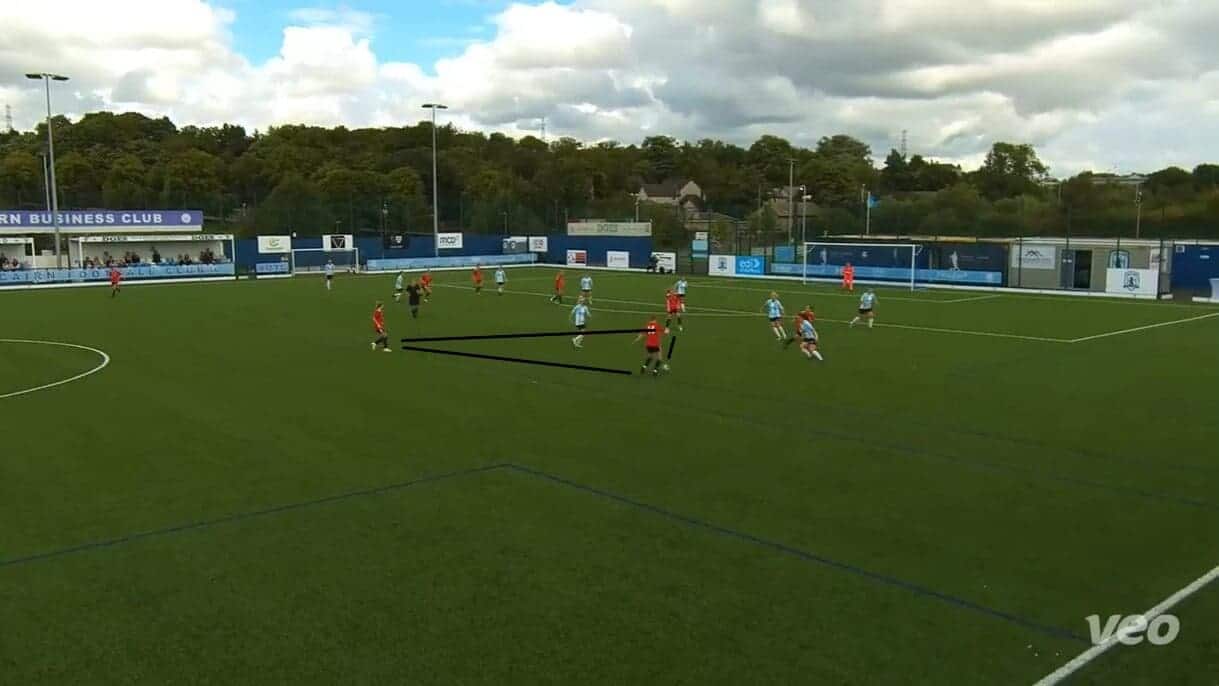
When they travelled to Gartcairn Women on the opening weekend, they had to show another side to their build-up play, with the home side focusing on being solid at the back but allowing Queen’s Park the freedom to move the ball around in the middle of the pitch.
As a result, a lot of the game featured the league leaders controlling play but not being able to construct the vertical lines that they did against Glasgow due to them having time but not the space to make them work.
Instead, it became about being patient with the ball and trying to probe the opposing defensive line in order to find a way through, with situations like this one between Darcy Molley, Kane, and Leah Daly common as they looked to keep the ball and to never allow Gartcairn to isolate one player and to have a chance of launching a counterattack.
It might not be what Queen’s Park like to do by choice, with it going against their principles of staying narrow and playing the ball up the field rather than across it, but this was one of those times when there was no alternative. Given that they came away with a 5-1 win, there is no doubting that it was the right decision tactically to make and one that yielded a positive result for them, and so shows again how their ability to adapt has been key to their strong start to the campaign.
Attacking threat
Building phases of play is only half of the story when it comes to Queen’s Park Women’s attacking play, though, with it also important to look at their ability to make the final pass and to test the goalkeeper, and it is clear from the fact that they have averaged 3.69 goals per game that this is just as big a reason for their improvement this season.
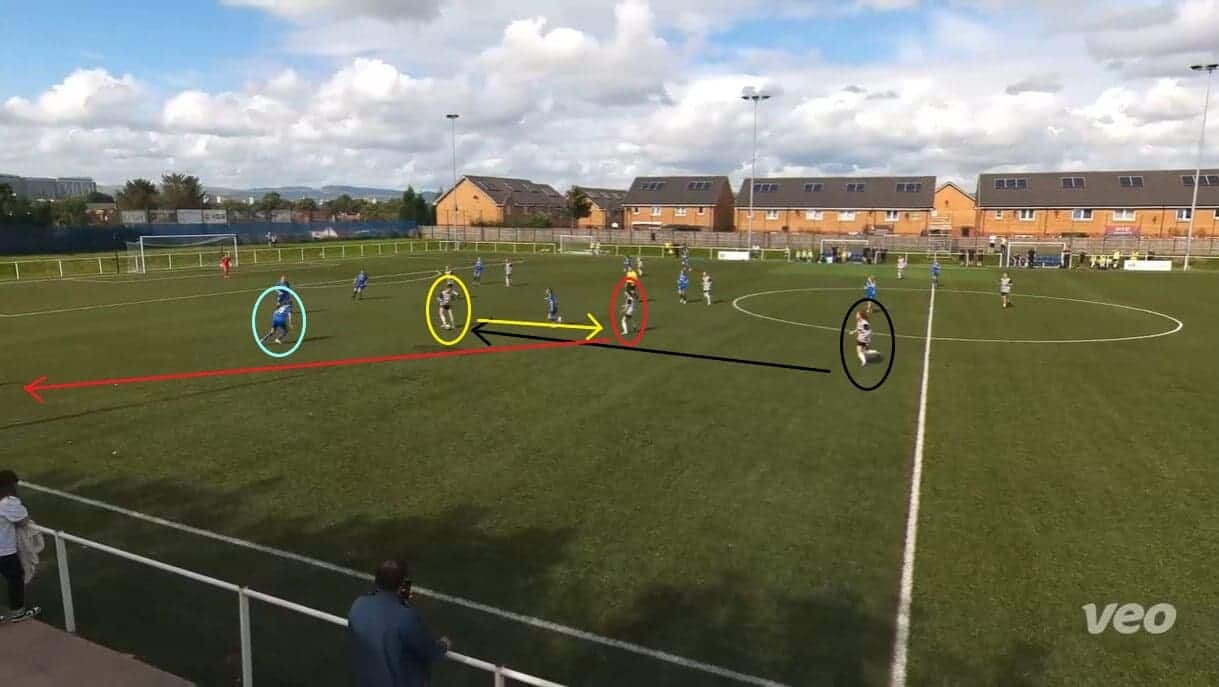
During the match with St. Johnstone Women, they had to partly play in the same frame of mind as they did against Gartcairn, with the visiting side trying to play with the same robust approach to make themselves as difficult to break down as possible.
However, unlike Gartcairn, St. Johnstone set up with wing-backs, and that was their undoing as it gave Queen’s Park the impetus to look for the suitable forward balls to make and to keep their passing sequences to a minimum. Here, Ciara Bonner has looked to find Quigley, who has then passed it back to Nicole Cairney, and it is at that point that the ball is sent beyond St. Johnstone’s right-sided wing-back Jodie Malcolm and into the path of left-back Taylor Davis.
Even though this chance didn’t lead to anything, with Davis’ cross being sent over by Molley, it is that ability to keep the ball moving and to pick the right pass at the right time that is clear to see here, and it shows how intelligent Queen’s Park are when they have the spaces available to attack into.
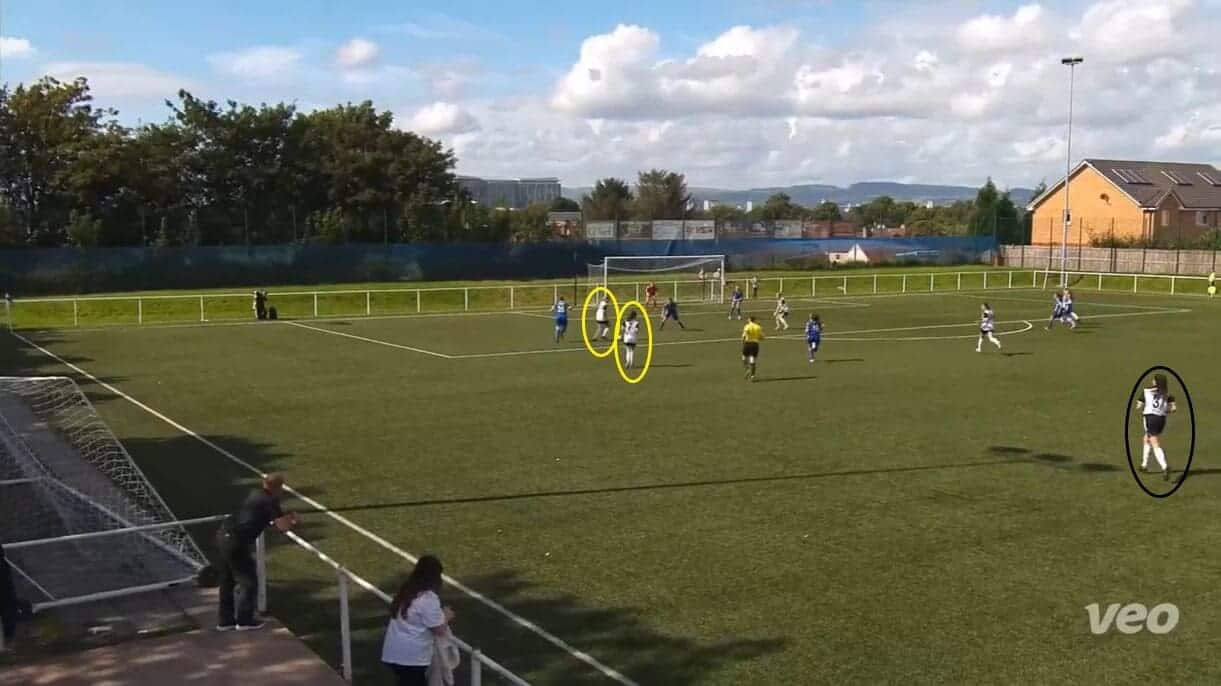
It is not only about crossing balls into the middle, though, with players also drifting infield to support those inside them (as well as to create those aforementioned vertical lines). This is where Davis and Molley play a vital and often unrecognised role, progressing high up the field whenever their side has possession and allowing those ahead of them to make those inside runs.
In this case, the presence of Davis on the wing, despite being quite far back, has allowed both Cairney and Emma Craig to make inverted runs, meaning that Queen’s Park have been able to increase their attacking threat in the middle and, therefore give themselves a stronger chance of converting the opportunity that has been created.
When considering how this allows Queen’s Park to potentially play with an overload in a dangerous area and to, therefore, take individual opponents out of the game, there is little doubt that the full-backs’ ability to control the wide channels and to enable them to move inside the pitch in this manner is another reason that they have been so potent and productive as the season has gone on.
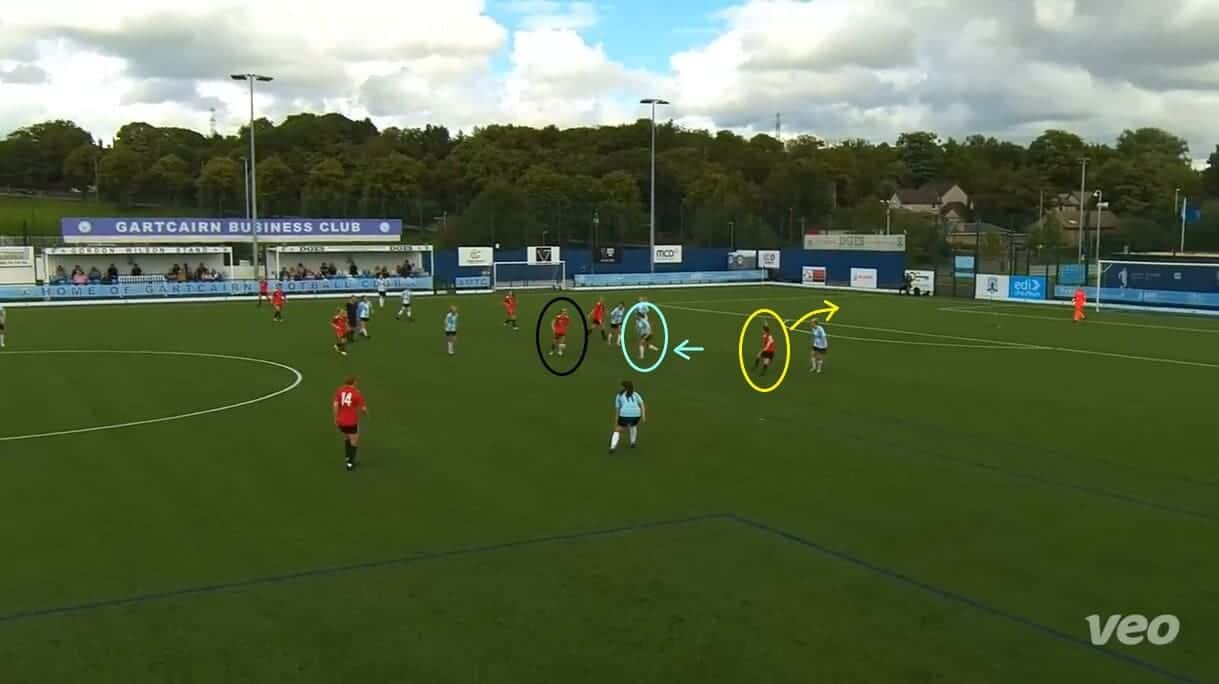
In both situations, the spaces were there for Queen’s Park to attack, but there have been some games when they needed to create them. As mentioned, Gartcairn were one of those opponents who tried to keep them out, so having a player like Kane becomes a benefit.
In short, Kane is a midfielder who also happens to be the league’s current top scorer, with her already having 19 goals to her name, and she can drift between the midfield and attack, which Queen’s Park have really used to their advantage as they try to manipulate opponents into leaving spaces open.
In this case, Gartcairn have fallen into the trap, with Madilyn Wilson following Kane and leaving a gap open for Monica Harty to exploit, and the ease of the move will have frustrated those watching in the home dugout. Whilst this particular attack may not have led to anything, with Gartcairn managing to recover and to prevent Queen’s Park from scoring here, it is this tendency to see Kane using her profile to fashion chances that is another reason that they have been able to match the variety of their build-up play with a clinical finishing quality.
Defensive setup
One theme that has run throughout this scout report has been teamwork, and that continues when breaking down Queen’s Park Women’s defensive play, with the league leaders conceding more than a goal per game (1.08 to be exact) but still having the joint-best record in the division with 10 recognised in total, alongside Boroughmuir Thistle. Therefore, as things stand, this side of their game looks just as likely to elevate them to the SWPL 1 at the end of the campaign as their attacking play is.
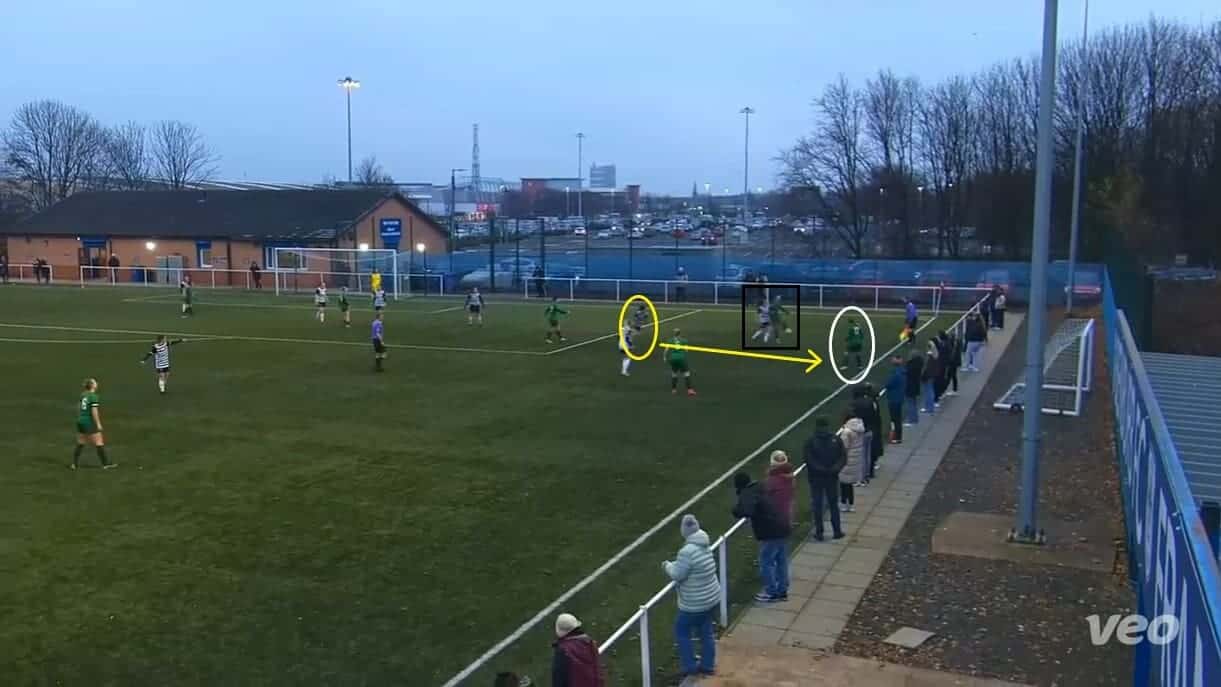
The tactical side of their defending is not that complicated, consisting of a simple player-to-player marking policy to ensure that opponents have as few opportunities to play their way into dangerous areas as possible. In this case, Stirling University Women have a throw on the nearside of the pitch but already have Chenoa Rainer marked by Bonner, whilst Cairney is quickly moving towards Rhianne Ferguson as the latter tries to assess her options.
Again, though, this only works because Queen’s Park defend as a team, with Stirling likely being able to play their way around the press if either Bonner or Cairney were not present here. Joyce’s side have won 72.6% of their defensive duels so far this season, and it is not hard to see why when looking at how they set up and work together in situations such as this.
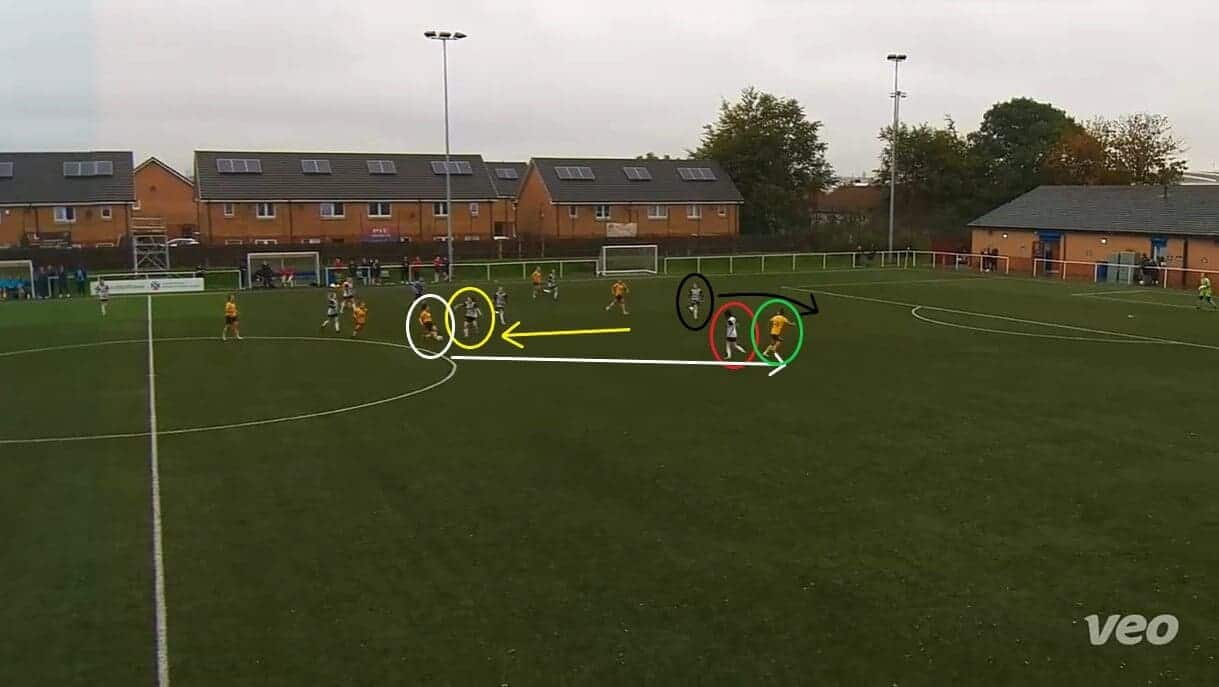
However, as with the attacking side of things, there are individual players without whom Queen’s Park would not defend with the same quality and strength and who often single-handedly prevent opponents from having easy chances to shoot at goal. The one who stands out for the leaders in this regard is Smith, with her providing the rearguard defence that allows the rest of the team to push forward and join the attacks.
There have been many occasions when she has saved her team and thwarted opposing attacks, and the visit of newly promoted Livingston Women was one match when her efforts really stood out. Livingston have performed well since entering the second tier and have shown themselves to be unforgiving when opponents do make mistakes, such as the decision of Bonner to move forward here and Cairney’s decision to turn her back on Erin Burns.
As a result of both of those, Sharon Hughes has managed to play Burns through behind the Queen’s Park line, and she would have likely scored here had it not been for Smith reading the play and getting across in time, with her changing the angle of Burns’ advance and ensuring that her effort ultimately failed to find the target.
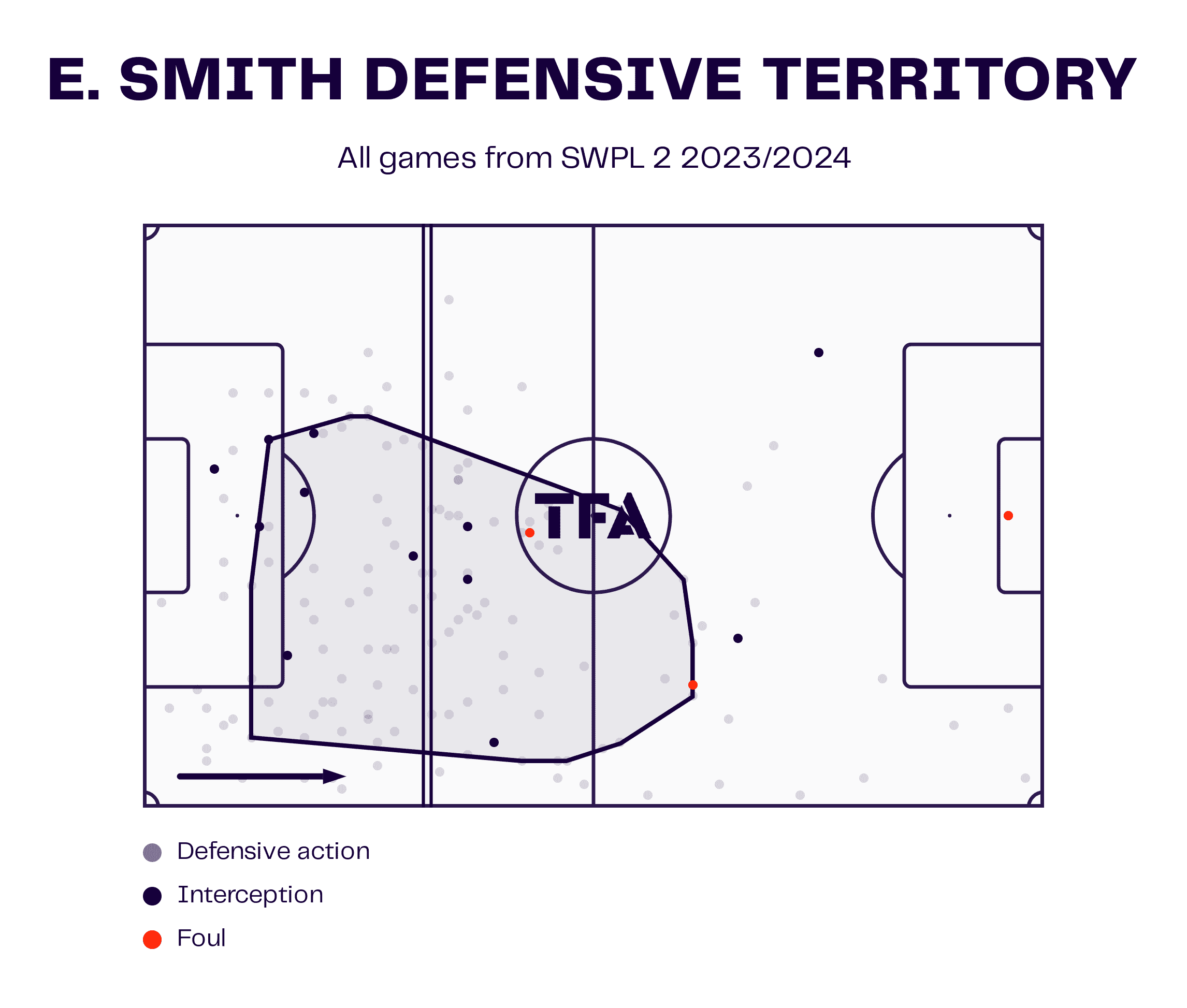
This graphic indicates just how many defensive contributions Smith has made so far this season and the areas in which she has intervened in opposing attacks, with her covering a vast amount of territory and making tackles, blocks and other defensive actions in so many areas of the field. Most noteworthy, given what happened against Livingston, are the six interceptions that she has made inside her goal area and the fact that she has averaged 3.93 per game, as well as winning 78.2% of her defensive duels and 65.2% of her aerial battles, indicates just how formidable she has been in these situations.
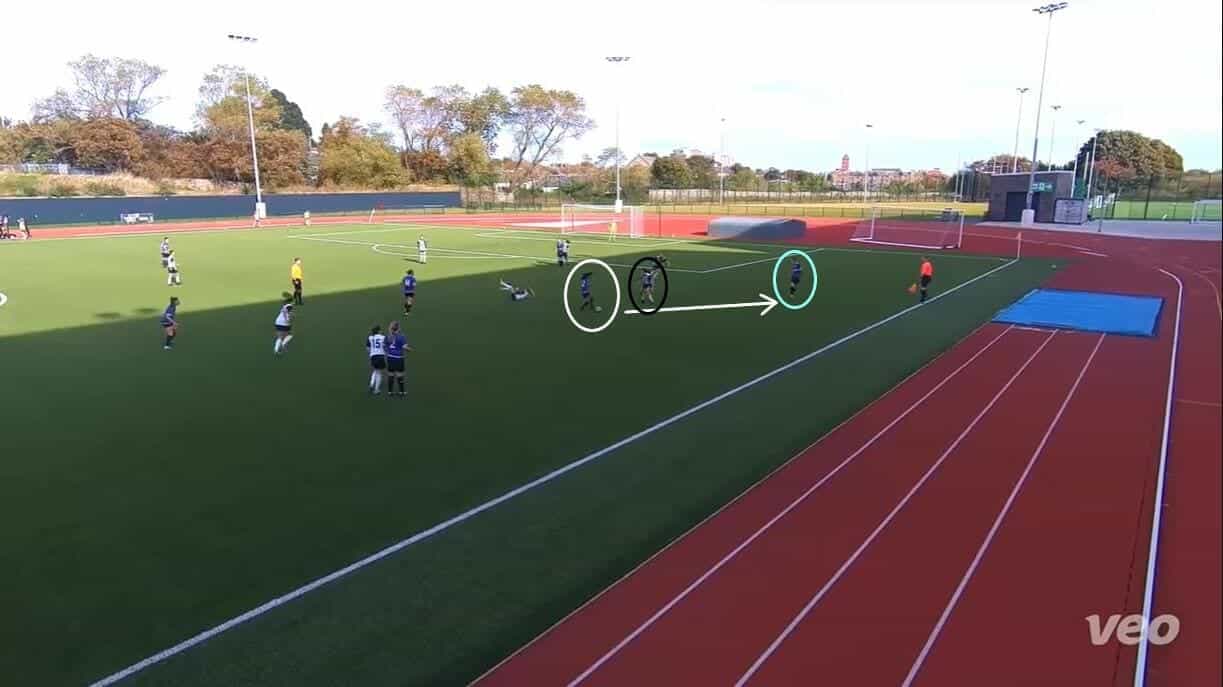
This is not to say that Queen’s Park have managed to deal with every situation, though, because there have been moments when they have left themselves open and have not been in a position to react in time.
The trip to Boroughmuir was one of those, with the home side quickly working out where their opponents’ weak points were and exploiting them as often as possible, with them trying to move the ball behind Queen’s Park’s full-backs before they could track back and get into position.
In this case, Davis has been caught on her heels by Abigail Varghese and the Boroughmuir player has combined with Fiona Gibson to take her out of the game. Even though Boroughmuir came away with a 3-0 loss from this match, their ability to work out how to break the league leaders down will be something that the rest of the league will have taken notice of, and it is something that Queen’s Park will need to watch as the campaign goes on.
Conclusion
In conclusion, this tactical analysis has looked in detail at current SWPL 2 leaders Queen’s Park Women, providing an assessment of their performances so far and showing why they are leading the charge for the SWPL 1 as things stand.
What has been clear from this analysis is that Craig Joyce’s side have made vast improvements on last season’s performances, with them always possessing basic tactical ideas last season but still showing signs of settling into a new style of play. This season, though, it looks as if everything has come together for them, with performances at a high standard and both attacking and defensive situations going mostly in their favour.
There is no doubt that the women’s game in Scotland is developing at an astronomical rate, with attendances, overall match quality and genuine inter-team competition all increasing, and it has been noticeable how Celtic Women and Rangers Women are now serious title contenders year on year (with others like Partick Thistle Women and Hearts Women not far away from joining in) and how more players are opting to taste life north of the border, with Real Madrid Femenino’s Paula Partido, who moved to Celtic on loan in the summer, just one of those.
Queen’s Park are desperate to see what it is all about and to follow in Montrose Women’s footsteps following the latter’s promotion in the summer. As things stand, they are very much on course to join them in the top flight next season.





Comments